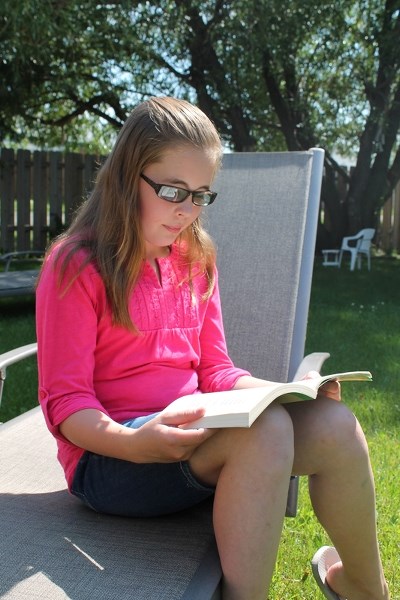Before she received a special set of lenses for her glasses that filter certain kinds of light, Gemma Smyth felt pain above her eyes whenever she read.
Words on the page would seem to double and it was difficult to focus.
But with the special lenses, it's now much easier for Gemma, a nine-year-old student going into Grade 4 at École Olds Elementary School, to read.
“When I have my glasses on, it's a lot better because sometimes I'm looking at the white board and I can't see anything,” she said. “So when we're supposed to write stuff off of it, it's really blurry for me so I have to get moved to the front and sometimes I still can't see it.”
The lenses Gemma wears block out certain light waves that interfere with her brain's processing of visual information.
This interference is known as Irlen syndrome, a disorder caused by sensitivity to light that affects perception and can cause problems when people read and write.
Words and images can appear blurry, moving or doubled and people often experience headaches and eyestrain while reading.
Gemma was diagnosed with the syndrome in December and received the lenses in February.
Lenses that filter out the light that causes the symptoms associated with the syndrome, along with coloured overlays that can be placed over paper, help people manage the syndrome.
Gemma's mother, Sue, said before she was diagnosed, teachers would often complain that Gemma needed to focus more in school and she struggled when reading at home.
“If we would be reading or something, you could just tell she's had enough within the first few minutes,” she said.
Last year, however, a teacher and secretary at the school suggested Sue take Gemma for Irlen syndrome testing in Innisfail with Nola Stigings, a certified Irlen diagnostician and president of the Canadian Association of Irlen Professionals.
During the testing process, Gemma was asked to read letters on a white piece of paper and she had to focus hard to decipher what she was reading.
When Stigings put coloured overlays over the words, however, Gemma could read them with ease.
“I could not believe the difference when she put these plastic overlays on,” Sue said, adding images of Gemma's brain during the testing showed high amounts of brain activity without the overlays and considerably less activity when the overlays were applied.
“What we're doing is filtering out the offensive wavelengths of light that are bothering the brain,” Stigings said. “By filtering those out, you're affecting the visual perception.”
Since she received the lenses for her glasses, the difference in reading for Gemma has been “night and day,” Sue said.
There are likely many parents with children suffering with similar symptoms who aren't aware of the syndrome and could benefit from the same testing Gemma received, she added.
That's why she is trying to drum up support for proposed provincial legislation that, if passed, would require any teacher who recognizes the symptoms of Irlen syndrome in a student to recommend testing to the child's parents.
Red Deer North MLA Mary Anne Jablonski put forth the proposed legislation, dubbed Bill 204, after her grandson was tested and diagnosed with the syndrome.
She said a teacher had described the symptoms of Irlen syndrome to her and it struck her “like a bolt of lightning” that the teacher was outlining exactly the kinds of problems her grandson was having with reading.
The bill has received first reading and will next go before the all-party Standing Committee on Families and Communities on Sept. 25 before second reading.
During the committee session, oral presentations will be heard from Stigings, the Alberta Medical Association, the Alberta College of Optometrists, the Alberta School Board Association, Helen Irlen, who identified the syndrome in the 1980s, and her daughter, active diagnosticians, a doctor with the syndrome and the teacher who first brought the syndrome to Jablonski's attention.
Jablonski said her intention is to have the bill become law by January 2015.
“I think you need to read to succeed and we have to do everything in our ability to help all children learn to read and if they have dyslexia or visual distress or any of those things, then we need, as educators, to make sure that we help them find what it is that they need so that they can read,” she said.
Stigings, who is one of three certified diagnosticians in the province that can test for the syndrome, said many people who have struggled with difficulties when reading, headaches, light sensitivity or other disorders may not have known they suffer from the syndrome and the proposed legislation will help raise awareness of the problem.
Once a person is diagnosed and given lenses or overlays, their reading abilities can improve in a short period of time, she added.
Screening for the syndrome costs $200 while the testing Stigings provides, along with the lenses, costs $725.
Some of the signs of the syndrome parents can look for in children include the rubbing of eyes, appearing sleepy or losing place when reading, difficulty focusing, restlessness or agitation, shielding eyes from lights and frequently sleeping in or staying up late.
For more information on Irlen syndrome, visit www.irlenalberta.ca.



